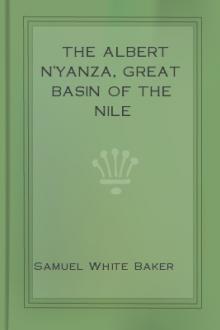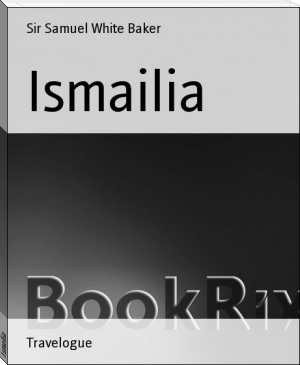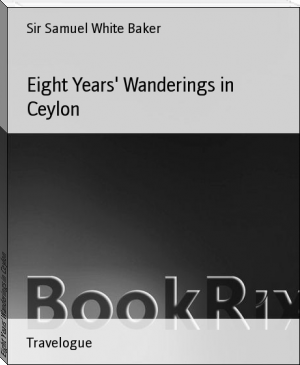The Albert N'Yanza, Great Basin of the Nile, Samuel White Baker [inspirational novels .TXT] 📗

- Author: Samuel White Baker
- Performer: -
Book online «The Albert N'Yanza, Great Basin of the Nile, Samuel White Baker [inspirational novels .TXT] 📗». Author Samuel White Baker
that a combined attack was to be made upon them by the natives.
Upon this excuse, Miani’s men refused to proceed, and determined to turn
back to Gondokoro; thus ended his expedition. I regarded the tree that
marked the limit of his journey with much sympathy. I remembered how I
had formerly contended with similar difficulties, and how heartbreaking
it would have been to have returned, baffled by the misconduct of my own
people, when the determination of my heart urged me forward to the
south; thus I appreciated the disappointment that so enterprising a
traveller must have felt in sorrowfully cutting his name upon the tree,
and leaving it as a record of misfortune.
With a just tribute to the perseverance that had carried him farther
than any European traveller had penetrated before him, we continued our
route over a most beautiful park of verdant grass, diversified by
splendid tamarind trees, the dark foliage of which afforded harbour for
great numbers of the brilliant yellow-breasted pigeon. We shortly
ascended a rocky mountain by a stony and difficult pass, and upon
arrival at the summit, about 800 feet above the Nile, which lay in front
at about two miles’ distance, we halted to enjoy the magnificent view.
“Hurrah for the old Nile!” I exclaimed, as I revelled in the scene
before me: here it was, fresh from its great parent, the Albert lake, in
all the grandeur of Africa’s mightiest river. From our elevated point we
looked down upon a broad sheet of unbroken water, winding through marshy
ground, flowing from W.S.W. The actual breadth of clear water,
independent of the marsh and reedy banks, was about 400 yards, but, as
usual in the deep and flat portions of the White Nile, the great extent
of reeds growing in deep water rendered any estimate of the positive
width extremely vague. We could discern the course of this great river
for about twenty miles, and distinctly, trace the line of mountains on
the west bank that we had seen at about sixty miles’ distance when on
the route from Karuma to Shooa; the commencement of this chain we had
seen when at Magungo, forming the Koshi frontier of the Nile. The
country opposite to the point on which we now stood was Koshi, which,
forming the west bank of the Nile, extended the entire way to the Albert
lake. The country that we occupied was Madi, which extended as the east
bank of the Nile to the angle of the Victoria Nile (or Somerset river)
junction opposite Magungo. These two countries, Koshi and Madi, we had
seen from Magungo when we had viewed the exit of the Nile from the lake,
as though a tail-like continuation of the water, until lost in the
distance of the interminable valley of high reeds. Having, from Magungo,
in lat. 2 degrees l6 minutes, looked upon the course of the river far to
the north, and from the high pass, our present point, in lat. 3 degrees
34 min. N., we now comprised an extensive view of the river to the
south; the extremities of the limits of view from north and south would
almost meet, and leave a mere trifle of a few miles not actually
inspected.
Exactly opposite the summit of the pass from which we now scanned the
country, rose the precipitous mountain known as Gebel Kookoo, which rose
to a height of about 2,500 feet above the level of the Nile, and formed
the prominent feature of a chain which bordered the west bank of the
Nile with few breaks to the north, until within thirty miles of
Gondokoro. The pass upon which we stood was the southern extremity of a
range of high rocky hills that formed the east cliff of the Nile; thus
the broad and noble stream that arrived from the Albert lake in a sheet
of unbroken water received the Un-y-Ame river, and then suddenly entered
the pass between the two chains of hills,—Gebel Kookoo on the west,
and the ridge that we now occupied upon the east. The mouth of the
Un-y-Ame river was the limit of navigation from the Albert lake. As far
as the eye could reach to the southwest, the country was dead flat and
marshy throughout the course of the river; this appearance proving the
correctness of the information I had received from the natives of
Unyoro, and from Kamrasi himself, that the Nile was navigable for some
days’ journey from the Albert lake. Precisely the same information had
been given to Speke, and the river level at this point showed by his
thermometer so great a difference between that of Karuma, that he had
concluded the fall of 1,000 feet must exist between the foot of Karuma
Falls and the Albert lake; this, as already described, I proved to be
1,275 feet.
It would be impossible to describe the calm enjoyment of the scene from
this elevated pass, from which we confirmed the results of our own
labours and of Speke’s well-reflected suggestions. We were now on the
track by which he and Gant had returned; but I believe they had rounded
the foot of the hill that we had ascended; the two routes led to the
same point, as our course brought us at right angles with the Nile that
flowed beneath us. Descending the pass through a thorny jungle, we
arrived at the river, and turning suddenly to the north, we followed its
course for about a mile, and then bivouacked for the evening. The Nile,
having entered the valley between Gebel Kookoo and the western range,
was no longer the calm river that we had seen to the south: numerous
rocky islands blocked its course, and mud-banks covered with papyrus
rush so obstructed the stream that the river widened to about a
mile,–this width was composed of numerous channels, varying in breadth
between the obstructing rock and island. Upon one of the rush-covered
islands a herd of elephants was discovered, almost concealed by the
height of the vegetation. As they approached the edge of the water and
became exposed, I tried about twenty shots at them with the Fletcher
rifle, sighted to 600 yards, but in no instance could I either touch or
disturb them by the bullets;–this will afford some idea of the width
of the river, the island appearing to be in the middle of the stream.
A short distance below this spot, the Nile rapidly contracted, and at
length became a roaring torrent, passing through a narrow gorge between
perpendicular cliffs, with a tremendous current. In some places the
great river was pent up between rocks, which confined it to a width of
about 120 yards, through such channels the rush of water was terrific,
but to a casual observer approaching from the north, the volume of the
Nile would have been underrated, unless calculated by the velocity of
the stream.
From this point we followed the bank of the Nile over a difficult route,
down steep ravines and up precipitous crags, by a winding path along the
foot of the range of syenite hills that hemmed in the river on the west
bank. Several considerable waterfalls added to the grandeur of the pass,
through which for many miles the angry Nile chafed and roared like a
lion in its confined den.
At length we arrived at a steep descent, and dismounting from our oxen
after a walk of about a quarter of a mile over rough stones, we reached
the Asua river, about a quarter of a mile above its junction with the
Nile. The bed was rocky; but although the Atabbi had subscribed its
waters above the point where we now crossed, there was merely a trifling
stream occupying about a quarter of the river’s bed, with a current of
about two and a half miles an hour. Crossing this on foot, the water in
the deepest part reached to the middle of my thighs. The Asua river, as
already described at the time that I crossed it on the route from
Farajoke to Shooa, is a mountain torrent formidable during the rains;
quickly flooding and quickly emptying from its rapid inclination, it is
exhausted during the dry season.
The crossing of this river was a signal for extra precaution in the
arrangement of our march: we had entered the territory of the ever
hostile Bari tribe; we had been already warned that we could not pass to
Gondokoro without being attacked.
We slept on the road, about seven miles to the north of the Asua. On the
following morning we started. The route led over a fine country parallel
with the Nile, that still continued in a rockbound channel on the west
of the march. Throughout the route from the Un-y-Ame junction, the soil
had been wretchedly poor, a mass of rock and decomposed granite forming
a sand that quickly parched during the dry season. The level of the
country being about 200 feet above the Nile, deep gullies cut the route
at right angles, forming the natural drains to the river.
In these ravines grew dense thickets of bamboos. Having no native guide,
but trusting solely to the traders’ people, who had travelled frequently
by this route, we lost the path, and shortly became entangled amongst
the numerous ravines. At length we passed a village, around which were
assembled a number of natives. Having regained the route, we observed
the natives appearing in various directions, and as quickly disappearing
only to gather in our front in increased numbers. Their movements
exciting suspicion, in a country where every man was an enemy, our party
closed together;—we threw out an advance guard,—ten men on either
flank,—the porters, ammunition, and effects in the centre; while
about ten men brought up the rear. Before us lay two low rocky hills
covered with trees, high grass, and brushwood, in which I distinctly
observed the bright red forms of natives painted according to the custom
of the Bari tribe.
We were evidently in for a fight. The path lay in a gorge between the
low rocky hills in advance. My wife dismounted from her ox, and walked
at the head of our party with me, Saat following behind with the gun
that he usually carried, while the men drove several riding-oxen in the
centre. Hardly had we entered the pass, when—whizz went an arrow over
our heads. This was the signal for a repeated discharge. The natives ran
among the rocks with the agility of monkeys, and showed a considerable
amount of daring in standing within about eighty yards upon the ridge,
and taking steady shots at us with their poisoned arrows. The flanking
parties now opened fire, and what with the bad shooting of both the
escort and the native archers, no one was wounded on either side for the
first ten minutes. The rattle of musketry, and the wild appearance of
the naked vermilion-coloured savages, as they leapt along the craggy
ridge, twanging their bows at us with evil but ineffectual intent, was a
charming picture of African life and manners. Fortunately the branches
of numerous trees and intervening clumps of bamboo frustrated the good
intentions of the arrows, as they glanced from their aim; and although
some fell among our party, we were as yet unscathed. One of the enemy,
who was most probably a chief, distinguished himself in particular, by
advancing to within about fifty yards, and standing on a rock, he
deliberately shot five or six arrows, all of which missed their mark;
the men dodged them as they arrived in their uncertain flight: the speed
of the arrows was so inferior, owing to the stiffness of the bows, that
nothing was easier than to evade them. Any halt was unnecessary. We
continued our march through the gorge, the men keeping up





Comments (0)